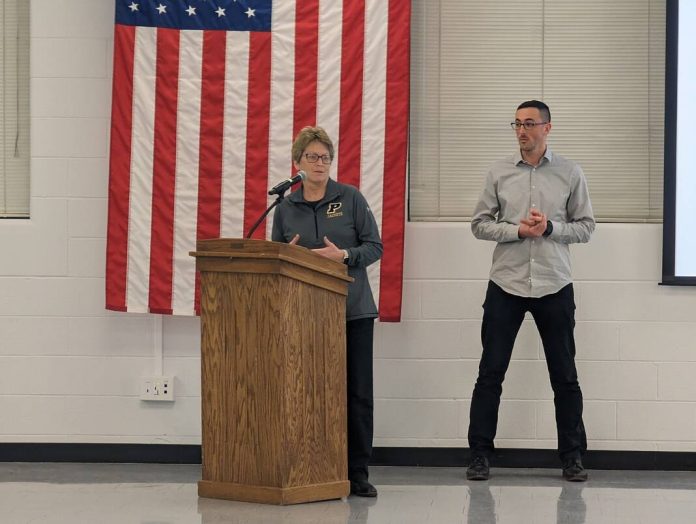
Perrysburg Schools Facility Assessment Committee members Jackie Derr, left, and Jacob Miley were among the 11 committee presenters at the special school board meeting on Wednesday.
PERRYSBURG — The school district has outgrown the current buildings and a detailed set of recommendations were laid out to the board of education on Wednesday in a new Facilities Master Plan.
“We can do better. We want the best. We want to be that destination district and we can do better,” said Jackie Derr, Perrysburg Junior High STEM teacher and committee member.
The Facilities Assessment Committee started its work on Feb. 1 last year. It has 61 members, including members of the public, the district employees and parents.
The plan recommends building a new 800-student, K-4 elementary to replace Frank Elementary, but to repurpose Frank Elementary for future use.
Board President Eric Benington noted that the committee made a unified recommendation for what they would like to see, but it did not come with costs or a way to pay for the plan.
“We need to know the cost, start nailing the numbers down,” Benington said.
The next steps will come later in the spring, after the Fiscal Analysis Subcommittee has had a chance to work with the fiscal office and Treasurer Randy Drewyor.
Drewyor discussed the possibility of eligibility for Ohio Facilities Construction Commission, which can cover up to 29% of costs as a reimbursement.
Funding with an additional levy was also briefly discussed. In 2024 there will be a district debt retirement of 2.0 mills, and in 2042 another 1.6 mills are retiring. There is also need for renewal or replacement of an operations levy that expires in 2024 and a permanent improvement levy in 2025.
The district has grown by 19%, or 919 students, since 2012. The group compared the growth to Ottawa Hills School District, which has approximately 1,039 students. Perrysburg Junior High School has 831 students.
The district currently has 5,800 students. The committee assumed an average 2% growth per year, and planned out until 2040, for a projected 8,400 students.
It also recommends additions to Toth, Woodland and Fort Meigs elementary schools.
The plan also recommends an analysis for the placement of the new school, based on projected growth patterns, but has suggested that the new elementary be in the southwest corner of the district.
It also recommends redistricting. Toth, Woodland and Frank are within a mile of each other, in the northern section of the district, while new growth has been oriented more to the south.
Suggestions for the future of Frank included use as a preschool. Currently the district holds preschool in a leased space in Maumee, but is limited to about 200 students. There is currently a waiting list to place students into preschool.
Frank would continue to be used for teaching at least until 2036, until the new building is finished and the other buildings catch up with their deferred maintenance needs.
There are many needs. Among those discussed were STEM, athletics, performing arts and special needs. Each activity requires additional space.
“Right now, we have a more updated STEM lab at the junior high, but right now if you were to have robotics in that class, there’s no space for that,” Derr said. “More space would require an extra instructor, and I already teach the extra class period. I can’t teach any more class periods.”
She said that there are students turned away from the popular class, because there aren’t enough teachers or space to hold the classes.
Frank is the second oldest elementary school, at 66 years, but according to an analysis by consulting firm the Collaborative, it has the least immediate deferred maintenance required, at $6.9 million. Fort Meigs requires $9.2 million, Toth $8.9 million and Woodland $9.4 million.
“Just due to their age, a lot of these things are getting to the end of their life: HVAC systems, electrical systems, roofing,” said Dave Serra, with the Collaborative Inc.
Cost analysis for the various systems are also confirmed by the Ohio Facilities Construction Commission.
Only Hull Prairie Intermediate has no deferred maintenance needs, because it is so new.
District-wide there is immediate need for $45 million in immediate deferred maintenance and $60 million total.
All the district schools were analyzed and the committee considered other options, including building a new high school and a new junior high.
The group also considered the cost of doing nothing. As a public school the district cannot turn away students.
Doing nothing would require the use of portable schools. There are already 12 portables in use across the district, but by 2040 there would need to be an additional 40.
Committee members were 100% against use of the portables because they are considered a poor investment, and the lifespan of those buildings is estimated at 12 to 15 years.
“Portables are not going to cut it,” committee member, alumna and parent Allison Reynolds Gogel said.
Superintendent Tom Hosler is putting together a page for the district website with frequently asked questions.
The next school board meeting is March 20, when questions can also be asked.




